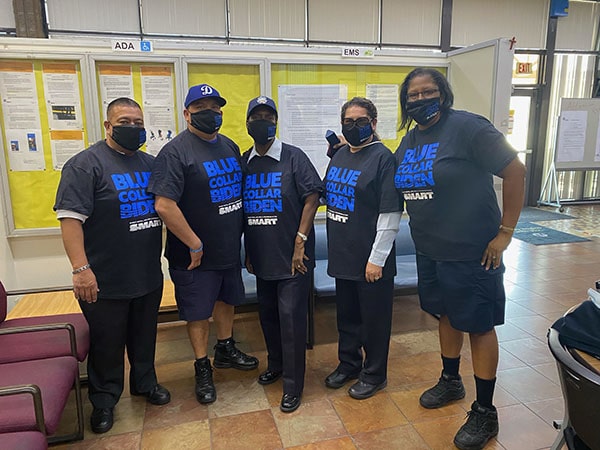SMART members are sending in their photos showing their support for Joe Biden, the presidential candidate who has been endorsed by your union. To submit your photos in support of candidates endorsed by SMART, email news_TD@smart-union.org.
To get involved, text SMART Army to 21333 and for voting information, text SMART vote to 21333.

Author: bnagy
Earlier this week marked the 40th anniversary of the Staggers Rail Act. The major railroads are celebrating this anniversary. That is not surprising because deregulation of the railroad industry, along with post-Staggers government approval of mergers and control transactions have produced a highly concentrated, but lightly regulated, industry. It has produced a 20-year run of historic profits for the railroads, and record returns for their shareholders. In the recent past, shippers had no complaints about Staggers because shipping rates declined in real dollars; but they now worry about the quality of service and railroad responsiveness to their needs: As a concentrated, but deregulated, industry, it has little need to answer to its customers.
This is a particularly inopportune time to celebrate passage of the Staggers Act because, in recent years, finance interests have led or pressured the railroads to exploit the deregulatory regime formulated when they were in economic distress to implement so-called “precision scheduled railroading” and other cost-cutting measures that have eroded service and eliminated tens of thousands of good-paying railroad jobs.
One group of major industry stakeholders never celebrated the effects of the Staggers Act: railroad workers. Between the passage of the Act and completion of the major merger and control transactions, rail industry employment was substantially reduced (from about 500,000 in 1980 to about 250,000 in the early 2000s).
Among other things, the Staggers Act facilitated sales of rail lines to smaller railroads that employed fewer workers, paid less and had less-beneficial work rules. Those sales were accomplished without traditional employee protections. At first, the Interstate Commerce Commission approved these types of sales after concluding that the lines to be sold were likely to be abandoned. But then it began to approve sales of what it called “marginally profitable” lines (which, by definition, were somewhat profitable). The major rail carriers protected their own interests in these transactions; they placed restrictions on the sales (physical or contractual) so that the purchaser railroads could interchange traffic only with the seller carriers; that way the major carriers divested themselves of less-profitable lines which gathered local freight, while ensuring that they retained the long haul movement of the freight generated on those lines. Rail Labor characterized these as sham transactions, but the ICC approved them, citing the Staggers Act and the deregulatory spirit of the Act. The ICC also allowed companies that owned existing rail carriers to acquire new lines that often connected with the lines of their existing subsidiaries without employee protections that were required when rail carriers acquired lines from other rail carriers by using the scheme of creation of new subsidiaries that the ICC treated as non-carriers since they were new corporations, even though they were commonly owned and controlled with existing carriers.
In approving the major merger and control transactions of the 1990s that reduced the number of Class I carriers to a mere handful, the ICC and Surface Transportation Board relied on Staggers Act amendments and the deregulatory mandate of the Staggers Act. Those transactions were approved based on the notion that shippers and the public would benefit from the consolidations. The railroads asserted, and the ICC and STB agreed, that mega-carriers would provide better and faster service through longer-end-to-end runs, reduced interchanges, and greater system velocity; that efficiencies would be achieved that would result in savings that would be passed along to shippers and the public in general; and that the economies of scale available to larger carriers would allow for increased investment in rail infrastructure.
During the same period that Congress and the ICC and STB deregulated the railroads and facilitated and approved consolidations as in the public interest, the agencies dramatically increased their regulation of Rail Labor by allowing the merging and commonly controlled rail carriers to use agency processes to gain dramatic changes in rates of pay, rules and working conditions outside the procedures of the Railway Labor Act. When the final big control transaction had been completed, railroad industry employment had been effectively halved, and rates of pay, rules and working conditions were forcibly and dramatically changed under the auspices of ICC and STB authorizations.
In the post-Staggers minimal-regulation environment, after the big merger and control transactions were consummated, the profits of the new mega-carriers soared. And for a while, the railroads followed-through on their representations that service would improve, and infrastructure investments would increase. But several years ago, hedge funds and private equity interests took note of railroad profitability and the very light nature of the regulatory regime for such a concentrated industry. There were attempted hostile takeovers of major railroads, and so-called activist investors increased their stakes in railroads; these financial interests promised to institute practices to reduce operating ratios (costs relative to expenses) and increase profits by dramatically cutting costs and service, by focusing on easier-to-serve/high-profit ratio customers, eliminating flexibility in pick-ups and deliveries of rail cars, requiring customers to conform to rigid schedules and lengthening trains (with some as long as 3 miles). This was accomplished through the so-called Precision Scheduled Railroading operating method. At the same time, capital infrastructure work was reduced to further improve operating ratios. As rail carriers that pursued this path saw their operating ratios decline, and their stock prices increased, other railroads adopted similar business models. Shipper complaints escalated. The STB held hearings and tinkered with complaint programs, but it generally was of the view that there was little it could do under the post-Staggers de-regulatory regime. In the meantime, rail employment again took a precipitous decline, from about 245,000 in 2015 to under 200,000 in January 2020. The profits of the major railroads have skyrocketed over this several-year period.
At the 40th anniversary of the Staggers Act, members of Congress, the STB and industry stakeholders should consider whether the current regulatory regime that was developed when the railroads were in financial turmoil and well before agency approval of the big merger and control transactions, makes sense today. Consolidation of the industry was approved because the transactions were deemed to be in the public interest. And with those approvals and the exclusivity that flows from holding an operating certificate comes the responsibility to provide adequate and responsive service. But the financial interests that are currently driving the industry have ignored those aspects of the approvals and the certificates. While a return to the heavy regulatory scheme developed before railroads had competition from aviation and trucking on the federal interstate highway system would not be appropriate, a regulatory approach recalibrated to recognize the reality of the industry as it is today is warranted.
This recalibration is necessary to ensure that rail customers receive adequate and responsive service, and that the industry continues to provide good jobs for railroad workers.
American Train Dispatchers Association
Brotherhood of Locomotive Engineers and Trainmen/IBT
Brotherhood of Maintenance of Way Employes Division/IBT
Brotherhood of Railroad Signalmen
International Association of Machinists and Aerospace Workers District 19
International Association of Sheet Metal Air Rail and Transportation Workers-Mechanical Division
International Brotherhood of Boilermakers
International Brotherhood of Electrical Workers
International Association of Sheet Metal Air Rail and Transportation Workers-Transportation Division
National Conference of Firemen and Oilers 32BJ/SEIU
Transportation Communications Union (TCU/IAM)
Transport Workers Union of America
Our union is in mourning after losing two of its active members this week: one in a work-related fatality and one in a traffic accident.
Ryan Sandy, 37, a member of Local 662 (Richmond, Va.) and a former local chairperson of LCA-201C, was killed in an on-the-job accident at 2:45 a.m., Monday, Oct. 12 in the Acca Yard in Henrico County, Va.
Sandy had been a member of SMART Transportation Division since February 2009 and worked as a conductor for CSX.
“We are all shocked and saddened by his passing,” fundraiser organizer Michael Carter posted. “It’s now our turn to give back and help his wife and their children as they deal with the loss of their loving husband and father.”
The National Transportation Safety Board has launched an investigation into Brother Sandy’s death, marking a change brought about by the insistence of SMART-TD safety leaders.
A number of worker fatalities over the past two years involving union workers went without an NTSB-led investigation, a situation that SMART-TD leadership made clear needed to be changed.
Across the country, Local 556 (Tacoma, Wash.) is mourning the loss of one of its officers.
Clayton Hoffman III, general chairperson of GCA-TMB (Tacoma Municipal Beltline) and local chairperson of LCA-TMB1, died in a fatal traffic accident Oct. 9. He was 43 years old.
The circumstances of GC Hoffman’s death are being investigated. He had been a member of the union since April 2004. He became GC on Oct. 1, 2012, and immediately set to work, said current Local 556 President Bill Price.
“During his time, Clayton negotiated one of the best contacts in shortline history for his members and brought those members to a livable wage,” Price said.
Price said that Hoffman served as a fierce representative of his fellow members and will be missed.
Local 556 brother Kody Henderson, local chairperson of LCA-001a, had this to say about his fallen brother:
“He was union leadership powerhouse and a union leader I looked up to. He was there when I initially took office in 2015 and helped guide me through this local chairman position. We would speak often, and as time went on we would reconnect to share stories and discharge stresses of dealing with management to one another.”
Brother Hoffman is survived by his brother, his sister and his mother.
“Clayton will be missed by all here at Local 556,” Price said.
The SMART Transportation Division offers its condolences to the relatives, friends and the brothers and sisters of Locals 662 and 556 on the passing of Brothers Sandy and Hoffman.
In a letter Sept. 28, Local 1741 President Sharon Chappill and General Chairperson Jadier Castano told the San Francisco Unified Schools and First Student that they are courting a school bus driver shortage whenever district schools reopen if they go through a plan to cut off health care coverage and lay off school bus drivers starting Oct. 1 prior to the reopening of in-person learning.
“If nothing is done, there is no question in our mind that there will be a driver shortage, as drivers and staff are compelled to look elsewhere for work to pay their rent and provide for their families,” they wrote. “We think the youth and families of San Francisco deserve better.”
“As we near a point-of-no-return, we are urging that (the San Francisco Unified School District and First Student) come together and find a way to provide for these vital components of a child’s education: school bus drivers.”
They asked supporters in the Bay Area to contact the school district to get them to find another solution.
“We hope that you will reach out and raise your voice in any way you can,” Chappill and Castano said.
Local 1741 leaders have organized rallies and encouraged activism at the virtual board meetings. In their letter, Chappill and Castano suggested that the drivers could help bridge the gap for students and families hit hard by the economic crisis, perhaps by providing food deliveries for those who need assistance.
“Please do not drive us away by cutting off our health care,” they wrote. “Please don’t throw our drivers under the bus.”
Brother Babiarz joined the union in January 1974 and was a GC from 2015 to 2019.
He is survived by his wife, Judith Kurtz.
Visitation is scheduled 1 to 4 p.m. Oct. 3 at Michaels Funeral Home, 800 S. Roselle Road, in Schaumburg, Ill., with funeral services beginning at 4 p.m.
Visit this link to leave condolences.




